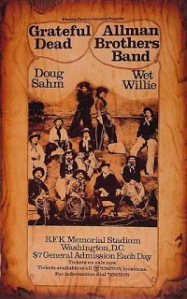I was introduced to the world of professional grade sound recording right before Christmas in 1971. A college friend of my father’s, Paul, took me with him to record a local community group’s performance of The Messiah at Montgomery Blair High School, in Silver Spring, Maryland. Paul brought me along with Jack Towers, several pricey Neumann microphones, and some portable Ampeg reel-to-reel recording decks. Portable in this instance meant each man had a foot-locker sized deck, along with a similar size pre-amp that had handles on the sides. Each piece required two people to carry it.
Paul could be described safely as an audio nut. In his Takoma Park basement, his hand-built home stereo included horns that had been used for early demonstrations of stereo in DAR Constitution Hall in the 1950s.
The horns provided part of his mid-range.
Paul was the official recordist of the world-renown D.C. Youth Orchestra. Soon I would accompany him regularly to the home of the DCYOP, Coolidge High School in D.C., quite often to the Kennedy Center which had opened recently, and to other events to record regional orchestral, chamber groups, choirs, and jazz. Again with Jack Towers, we recorded jazz violinist Joe Venuti at Georgetown’s Blues Alley on his final D.C. visit before a return to Italy, where he died two years later.
I already had a taste for many different types of music. I enjoyed Top 40 radio that was heavy on Motown, and was collecting Aretha Franklin albums. I would listen repeatedly to any song that provided multiple full-body orgasms, wondering how that happened. I convinced my mother to take me to Constitution Hall to see Leonard Bernstein and the N.Y. Philharmonic in August 1967 on Bernstein’s last trip through the area as the NY Phil’s conductor, and Paul took me to Constitution Hall to attend a performance by the great Russian pianist Emil Gilels. Paul was an enthusiastic opera fan and season-ticket-holder for Constitution Hall concerts, and after each piece he would place his open hand next to his mouth and shout “Bravo!” at the stage many times. I was not used to such unashamed enthusiasm.
The only pop concert I attended early on was Peter, Paul & Mary at the Carter Barron for my 13th or 14th birthday, but I only wanted to go because John Denver was opening for them. (It had been sparsely attended while afflicted with light showers.) During my mid-teens, I regularly listened to a jazz anthology series on Public Radio which had 180 half-hour episodes; they were played late nights and early mornings, and my nocturnal orientation often allowed me to hear two episodes a day. I heard most of them at least three times before it wasn’t on the schedule any longer. It was like attending my own secret jazz school. The episodes were written with emphasis on each artist’s personal story as related to their music career, and, while often tragic, many of these stories left me with a deep longing for stories of current-day musicians that felt as important and influential.
24 March 1973 found me at my first rock concert. I rode sliding, seated on the wooden floor in the back of a rented yellow Ryder truck with a bunch of hippies from school, to the Spectrum in Philly, to see The Grateful Dead. I had only heard their album American Beauty on a friend’s pitiful portable, so to suddenly experience an eight-minute Tennessee Jed and perfect 19-minute Playing In the Band through their clear-sounding JBL and McIntosh-based sound system, was rich nutriment to my hungry ears. It changed my life. When the Dead came to RFK Stadium that June 9 and 10 for a co-headlining weekend with the Allman Brothers, I had to attend both shows. I slept on the lawn at RFK with my face planted on my bandana after the first day’s show, too.
For years I played drums with many guitarists and bass players in various band attempts. We rarely got out of the basement, but I took an interest in learning the sound reinforcement gear. Thanks to my grandmother, I attended Omega Recording Studios in Kensington, for basic and advanced recording engineering courses. With my longtime enthusiasm as musical omnivore and in the preservation of sound recordings, when I applied in 1990 to work as a playback technician in the stacks of the largest recorded sound collection in the world at the Library of Congress [LC], I was a natural fit. I’m confident that when my supervisor-to-be asked each candidate what we knew about the preservation of sound recordings, few others provided a 25-minute answer, and none continued for 35 meticulous minutes visiting several continents, when asked what kinds of music they were familiar with.
Music that was this accessible as it took one through glorious 20-minute dancing tapestries of buoyant harmonic changes, with instrumental solos and multi-layered vocals, to deliver one in a tidy package to a different place quickly seemed the obvious norm. This was what rock music could provide and did provide. Imagine my surprise when I attended a rock concert where a band played its songs more or less like their studio recordings, then were done. I felt ripped off!








